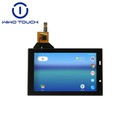1. Comparison of visual effect
Both capacitive and resistive touch screens have good visual effects indoors, but the visual effects outdoors, especially under sunlight, which show a difference. Resistive touch screens reflect sunlight because of the extra screen level making the visual effect worse, therefore, in outdoors, the capacitive touch screen display effect is better.
2. Touch sensitivity comparison
Capacitive touch screens work by using the body's current induction, so any non-conductive objects such as fingernails and gloves cannot be identified by the capacitive sensing system below the screen. Resistive touch screens work through pressure sensing, using any object touch can be, support stylus.
3. Comparison of resistance to damage
The outermost layer of the capacitive touch screen is a protective layer of silica glass, which is likely to shatter under severe impact. The outermost layer of the resistive touch screen is a thin film, which needs to be pressed down to achieve pressure sensing, and the resistive touch screen supports the stylus, making the screen prone to scratches, requiring protective film and relatively more frequent calibration, but it is less likely to break than the capacitive touch screen.
4. Comparison of cleanliness
Capacitive touch screens are easy to touch with your fingers, leaving stains on the screen, but because the outermost layer is glass, it is easier to clean. The resistive touch screen supports the operation of stylus or nails, which is not easy to dirty the screen, but easy to leave scratches.
5. Comparison of environmental adaptability
The typical operating temperature of a capacitive touch screen is between 0° and 35° and requires a minimum of 5% humidity. Resistive touch screen do not have a specific value for operating temperature, normal it can work normally at temperatures from -15°C to +45°C and have little requirement for humidity.
6. Comparison of accuracy
Capacitive touch screens can theoretically reach a few pixels, but in practice they are limited by the contact area of the finger, making it difficult for users to precisely click on targets smaller than 1cm2. In contrast, the precision of resistive screens reaches at least a single display pixel, which can be seen when using a stylus. Facilitates handwriting recognition and helps in the operation of interfaces using small control elements.




